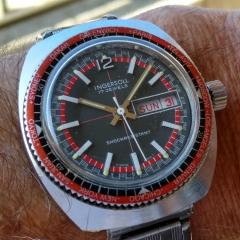-
Recently Browsing
- No registered users viewing this page.
-
Topics
-
Posts
-
By RichardHarris123 · Posted
I looked up bombè, domed in French. It's pronunciation is bomb, does a bomb (explosive device) get It's name from bombè? I know we're going off subject but it's interesting. -
By ManSkirtBrew · Posted
Okay, I checked with the fine folks at the McCaw Company, and they agree it's the correct crystal, and they have one in stock, so with that sorted time to get onto assembly. Starting by getting the spring into the barrel, which was a bit harrowing. It took me several tries to get it hooked onto my worn old winder arbor, but I did find a new use for the micrometer stand I just purchased. Carefully dabbed some Kluber P125 braking grease to the left of the divots around the barrel, and a little HP1300 on the floor of the barrel before popping it in--in case you haven't seen it, this is a great illustration I found somewhere on this site. You're not the boss of me, Bulova. 2172_Bulova 11AOAC 11AOACD 11AOACB.pdf Bulova_11 AOAC, D, B(1).pdf I got the train back in and it didn't seem as free as I'd like. Looks like the driving wheel with cannon pinion has zero end shake. That could explain the low amplitutde I started with. Now if you were me, would you push on the plate jewel or the bridge jewel? I've attached some extra pictures in case anyone sees something else I'm doing wrong here. -
I have quite a few watch brands from all over the world. For some reason this Timex electric from 1979 is capturing my attention this week. I am not a particularly fond of battery operated watches or Timex, but this one is different for some reason. Post your watch in your collection that seems to draw you in more now than before...
-
By nickelsilver · Posted
You can use bombe jewels with regular pivots if you put the convex surface facing the shoulder. You see it on (primarily older) high end pieces, particularly nearer to and including the escapement.






Recommended Posts